We decided to not provide a printed user manual with every kit to reduce waste and contribute to sustainable science. You can find a QR code inside the kit to download the user manual. You can also find manuals on the corresponding product page under “Product Resources”.
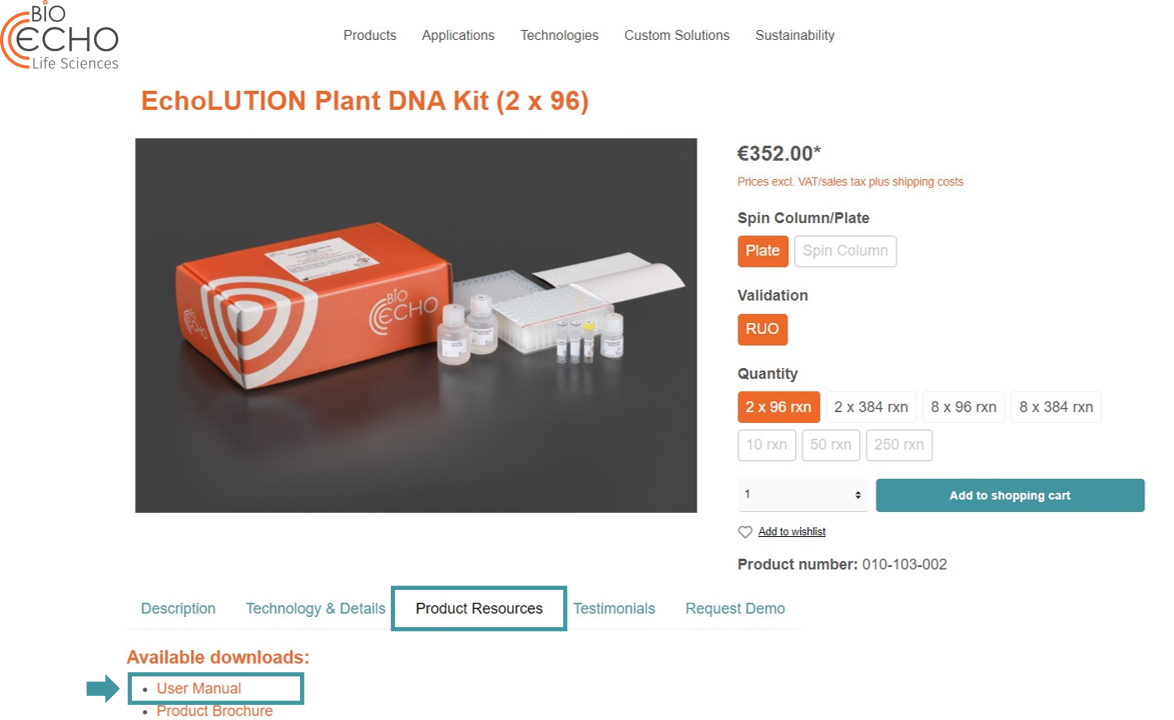
Please request the SDS via QA@bioecho.de or contact your Sales Representative.
Please request the CoA via QA@bioecho.de or contact your Sales Representative.
- We do not use organic solvents such as ethanol during our extraction, so forget about the carry-over of such components in your nucleic acid extraction.
- We reduce the use of hazardous reagents to a minimum so you will have a user and environmentally friendly product.
- Extract your samples at room temperature.
- The EchoLUTION technology is a single-step purification method, which makes it faster compared to conventional methods. Say goodbye to bind-wash-elute methods, and welcome EchoLUTION in your laboratory routine.
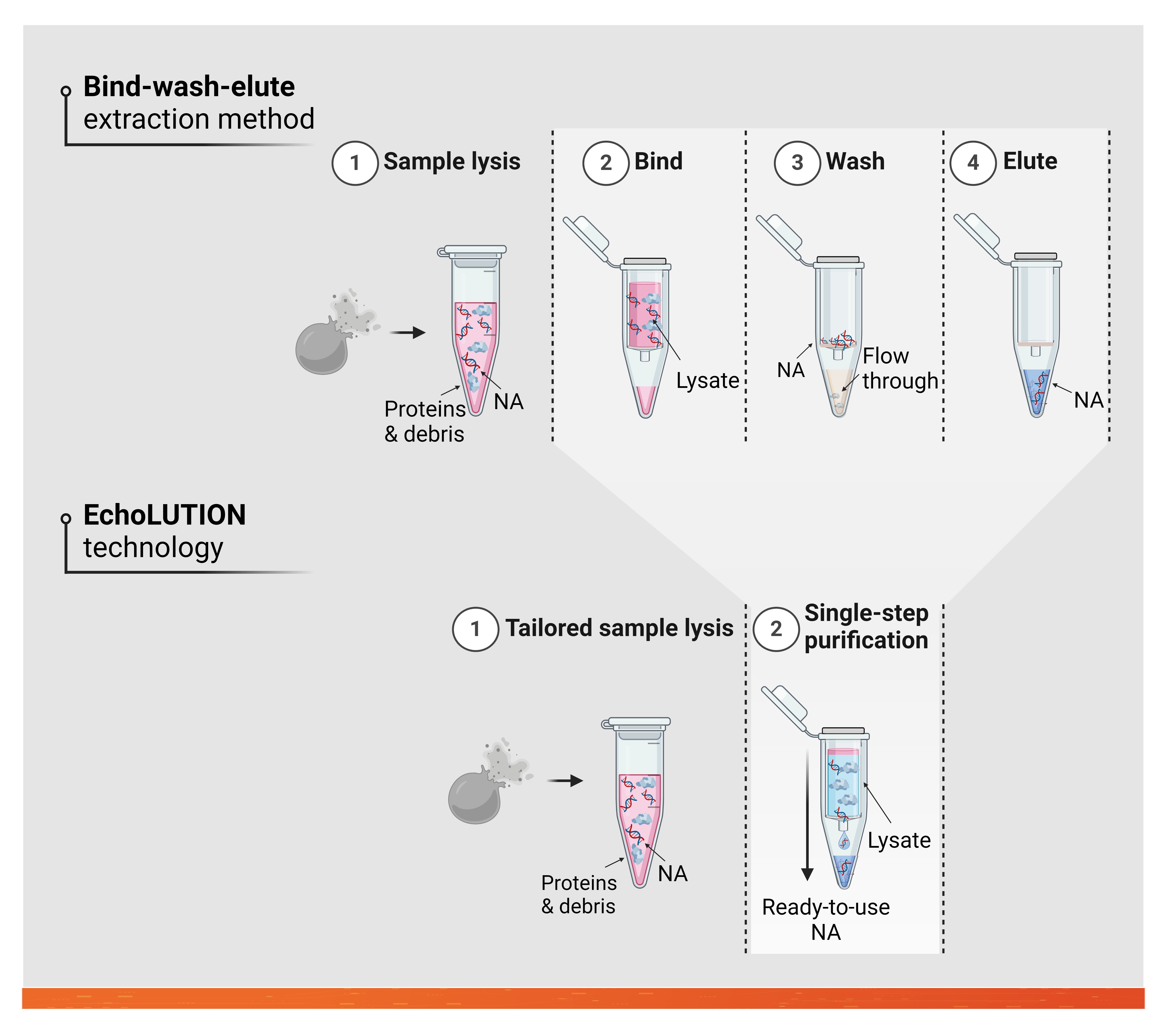

If you need further information, visit our technology page. If you have specific questions, please reach out to support@bioecho.de
There are several ways you can benefit by switching to BioEcho; here are just a few:
- The EchoLUTION technology is a single-step purification, which makes it faster compared to conventional methods.
- Due to the reduced number of steps and less packaging, EchoLUTION is a sustainable choice.
- EchoLUTION uses a different technology than magnetic beads and silica methods, which means it might work better for samples for which these methods do not work well.
- Only standard lab equipment is needed (centrifuge with swing-out rotor)
- If you would like to know more about the advantages of using BioEcho products, visit our technology page, or check out our technology video
- Reduce associated costs to your nucleic acid extraction like consumables or waste disposals. Find more information here.
With our innovative EchoLUTION technology, we want to prove that modern molecular biology can be both sustainable and innovative. That can be explained by the 3Rs model: Reduce, Reuse, and Recycle.
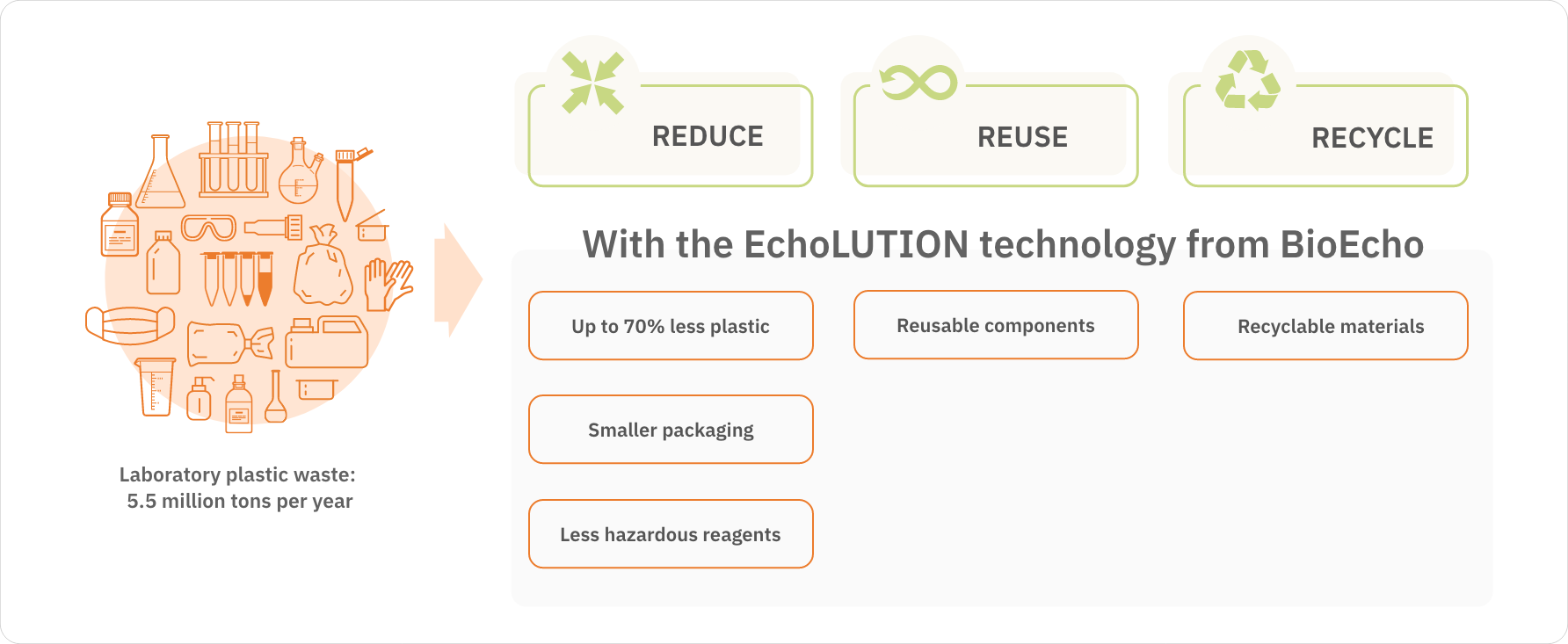
We invite you to read more about our sustainability concept!
We see sustainability as a holistic approach. Therefore, every department contributes to an environmentally friendly business. Here are some examples:
- Marketing and Sales: Fewer printed marketing materials User manuals are only available online!
- Supply Chain Management: Preference for suppliers from Germany and Europe to reduce the carbon footprint.
- Manufacturing: Reusable kit components can be purchased separately.
- Research and Development: we are a green-level certified laboratory by My Green Lab.
- Purchasing: Suppliers requested to reduce unnecessary packaging materials.

Following our sustainable approach, we do not include reusable components, such as the Conditioning Plate in our kits as they can be reused several times. These reusable components are purchased separately. To purchase them, please make sure to select the correct ones depending on the format. For 96-well plates (click here), for 384-well plates (click here) and for diagnostic products (click here).
Spin column products can be performed in a microcentrifuge with a rotor for 2 mL reaction tubes. The centrifuge must be capable of reaching at least 4,500 x g. For our FFPE products, the microcentrifuge must reach a speed of 19,000 x g for the phase separation. Spin column products can also be processed with a plate centrifuge with swing-out rotors. When using a plate centrifuge, please remember to use our Spin Column Adapter for Plate Centrifuges (product number 050-011-024)
Plate formats require a plate centrifuge with a swing-out rotor capable of 4,500 x g (minimum 1,500 x g) and buckets that hold plate stacks of 5 cm.
If you have further questions about the specifications for centrifugation, please contact us at support@bioecho.de
The EchoLUTION technology is a completely new way of nucleic acid extraction and cannot be compared with silica-based methods. To ensure that the matrix sediments correctly, it is recommended to use swing-out rotors. For spin columns, a slightly tilted surface according to the angle of the rotor (usually 30°) is to be expected, and this does not limit the purification ability. If you observe that the matrix is tilted to a higher angle (see picture below), we recommend prolonging the standing time after resuspending the column for up to 30 minutes, or up to overnight before conditioning. Alternatively, if you want to avoid prolonging the standing time, we suggest using a swing-out rotor centrifuge with our Spin Column Adapter for Plate Centrifuges. You can find them here.

We recommend using the Spin Columns and Purification Plate directly after conditioning. However, if you prepared your columns and plates in advance and left them standing after conditioning for a few hours, no worries, they can still be used, as long as the matrix does not present cracks. A cracked matrix indicates that this one has dried out, and the product should no longer be used. Therefore, we recommend checking the matrix visually before using it.
No, it is not possible to use unused wells after conditioning, as all the wells in the plate are conditioned. If you usually do not need the full plate, we recommend using our spin column formats. If you would like to know about alternative options, please contact us at support@bioecho.de
The EchoLUTION technology is a new way of nucleic acid extraction based on a different purification principle and chemistry (buffer solutions) than the silica or magnetic bead-based method, which might make them incompatible. Therefore, we do not recommend using nor mixing vendor chemistries. Additionally, we would not be able to support you or do correct troubleshooting if you have problems with nucleic acid quantity, quality, or performance in downstream applications.
As different kits use different purification matrices, depending on the sample type, we recommend using only the Spin Columns and Purification Plate specified for each sample type. Using a column or plate for another sample type could result in insufficient quality, quantity, and performance in downstream applications. If you have any questions, please contact us at support@bioecho.de
Unfortunately, this is not possible. Using a higher lysate volume than the recommended in the user manuals can result in incomplete removal of unwanted components and inhibitor carryovers. Please ensure that you are working with the loading volumes specified in the specific manual.
To ensure optimal performance of the purified nucleic acids, we recommend directly preparing your downstream applications, such as PCR, RT-PCR, or NGS. If not possible, store RNA samples at –80°C and DNA at –20°C to preserve their integrity. Additionally, minimize freeze-thaw cycles to prevent potential nucleic acid degradation. Nucleic acids are stable at the mentioned temperature for at least 1 year.
A demo offers you the best chance to evaluate if we are the right partner for you! You’ll get the product for free and invest only a minimum of time to get a thorough introduction to our technology. Also, we see our demos as a safe space to ask any questions. We will be onsite to provide tips and tricks and optimize or troubleshoot your workflow. If you would like to have a demo click here.
No, it is not. Air bubbles might indicate an inappropriate spin column homogenization. To homogenize the matrix in the spin columns, the spin columns need to be vortexed thoroughly. You can perform this step in an upright position, on the side, or upside down depending on what works best for you. If air bubbles are visible (see picture), it is mandatory to remove them completely. To remove air bubbles, flick or gently spin down by hand until it is free of air bubbles or quickly vortex again in an upright position at the end. Place each column in a 2 mL reaction tube (not provided) and let them stand to sediment the matrix until used. For improved sedimentation of the matrix, we recommend that this step is performed upon receipt of the kit and store them in an upright position, but at least 10 minutes before preparation
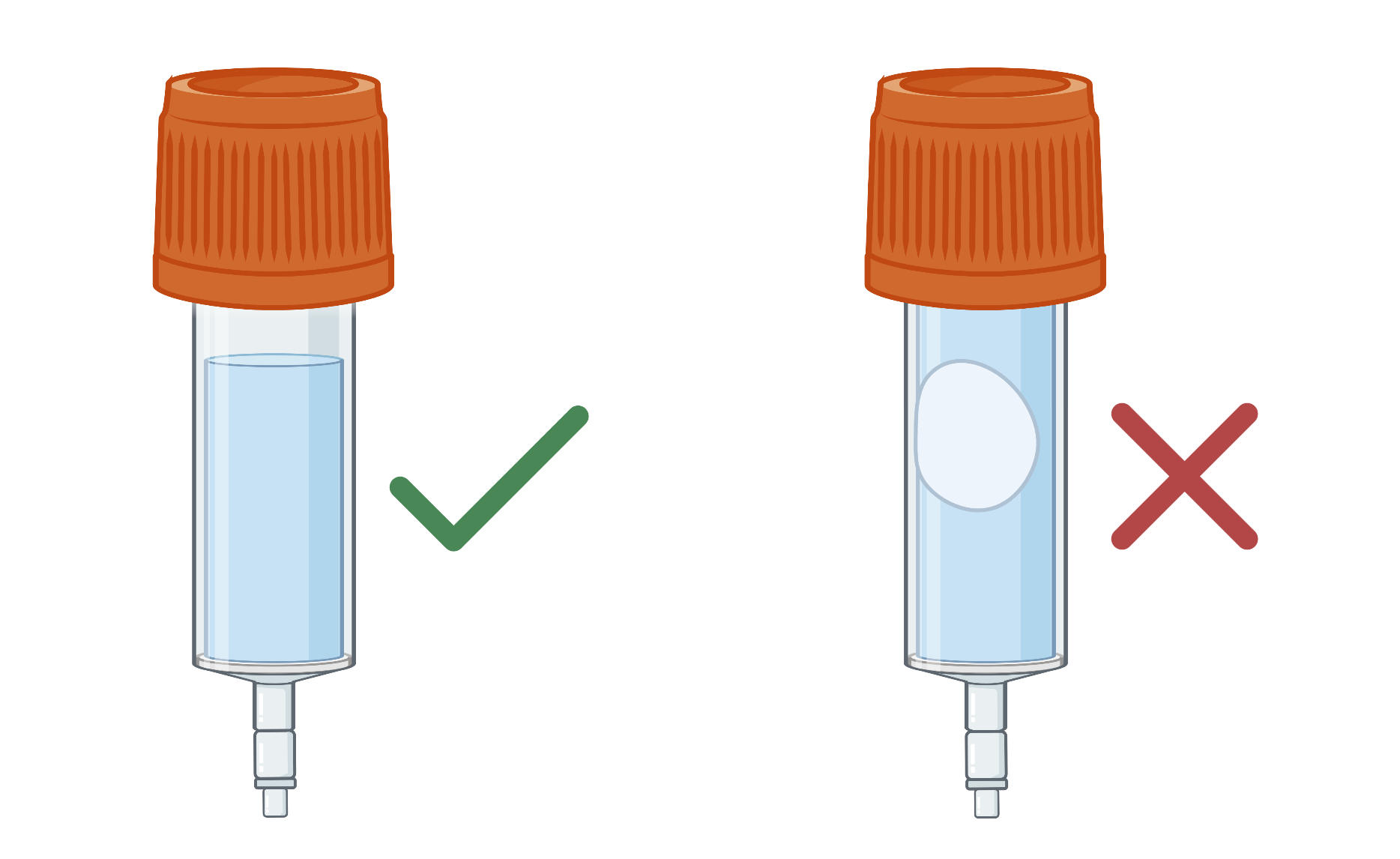
A highly tilted matrix after conditioning leads to insufficient interaction time between the DNA and the matrix, which can result in poor extraction performance. However, when using fixed-angle rotor centrifuges, the matrix does not become fully horizontal after conditioning. A slightly tilted surface according to the angle of the rotor (usually 30°) is to be expected, and this does not limit the purification ability. But if you observe that the matrix is tilted to a higher angle (see picture below), we recommend prolonging the standing time after resuspending the column up to 30 minutes, or up to overnight before conditioning. For quicker processing, we recommend to vortex the spin columns upon receipt of the kit and storing them in 2 mL microcentrifuge tubes in an upright position till used. Another reason could be that the spin column was completely closed during centrifugation and a vacuum was generated. Alternatively, if you want to avoid prolonging the standing time, we suggest using a swing-out rotor centrifuge with our Spin Column Adapter for Plate Centrifuges (product number: 050-011-024)

Purification Plates need to be stored cold (2–8 °C) and in the position mentioned on the label. If you store them at the wrong temperature, we cannot guarantee a good quality of nucleic acid extraction. Therefore, we recommend ordering a new product. If plates are stored at the right temperature but in the wrong position, please do not open them, place them in the correct position for (minimum one hour) before using them. After this time, you can continue with the Purification Plate preparation and nucleic acid extraction.
In general, we recommend our customers avoid prolonging the incubation time or the temperature during lysis. Our products have different types of tailored lysis depending on the sample input (see image). For the kits with an ultra-fast lysis type, we strongly recommend sticking to the time and heat mentioned in the user manual for these products, as an increase in time and temperature will lead to nucleic acid degradation. Our FFPE products with xylene-free decrosslinking and deparaffinization, differs from other products on the market, which perform overnight lysis, we do not recommend prolonging the incubation time either as this might lead to nucleic acid fragmentation and degradation. If you have further questions, please contact us at support@bioecho.de

Heat-shaking is a crucial step to guarantee an optimal lysis. However, if you do not have a heat-shaker instrument or would like to know if you can use an alternative method, please contact us at support@bioecho.de. We have had several customers that use different alternatives, and we might be able to support you here with some options.
The adhesive foil is used during incubation periods. This foil is air-permeable and avoids cross-contamination.
Our products are available in spin columns, 96- and 384-well plate formats, giving you the flexibility to go from a low to a mid and high throughput. With our EchoLUTION Cell Culture RNA and EchoLUTION Plant DNA 384 formats, you can purify four times 96 samples within one centrifugation step of one minute. You cannot go faster than that!
If you have a project where you would like to scale up your throughout, please contact us at support@bioecho.de
The coloration of the eluate may indicate column overloading. If you see effects in your downstream application when using colored eluates, the amount of sample used should be reduced. Here you can find a nice overview of known PCR inhibitors from different sample types. If decreasing your sample input does not help, please contact our specialists at support@bioecho.de
The DNA integrity number (DIN) and RNA integrity number (RIN) determine the integrity and degradation of nucleic acids. Different from the DV200, which evaluates the percentage of RNA fragments above 200 nucleotides.
Yes, our EchoLUTION Tissue DNA Kit works with samples stabilized in ethanol, formaldehyde, and RNA stabilization buffers like PurifyLater and RNAlater. If you would like to know more about this, and get a working protocol, please contact our specialists at support@bioecho.de
Yes, it is possible to automate our EchoLUTION plate formats (96- and 384-well plates). To meet the needs of our customers and help them increase their throughput with high reproducibility, we have worked on different fully or semi-automated solutions for our products. If you would like to get more information about automation or would like to work together to develop a tailored automated protocol, contact our specialists at support@bioecho.de
Our RNA extraction kits have been shown to efficiently extract miRNAs. For further information please refer to the product information or contact us at support@bioecho.de
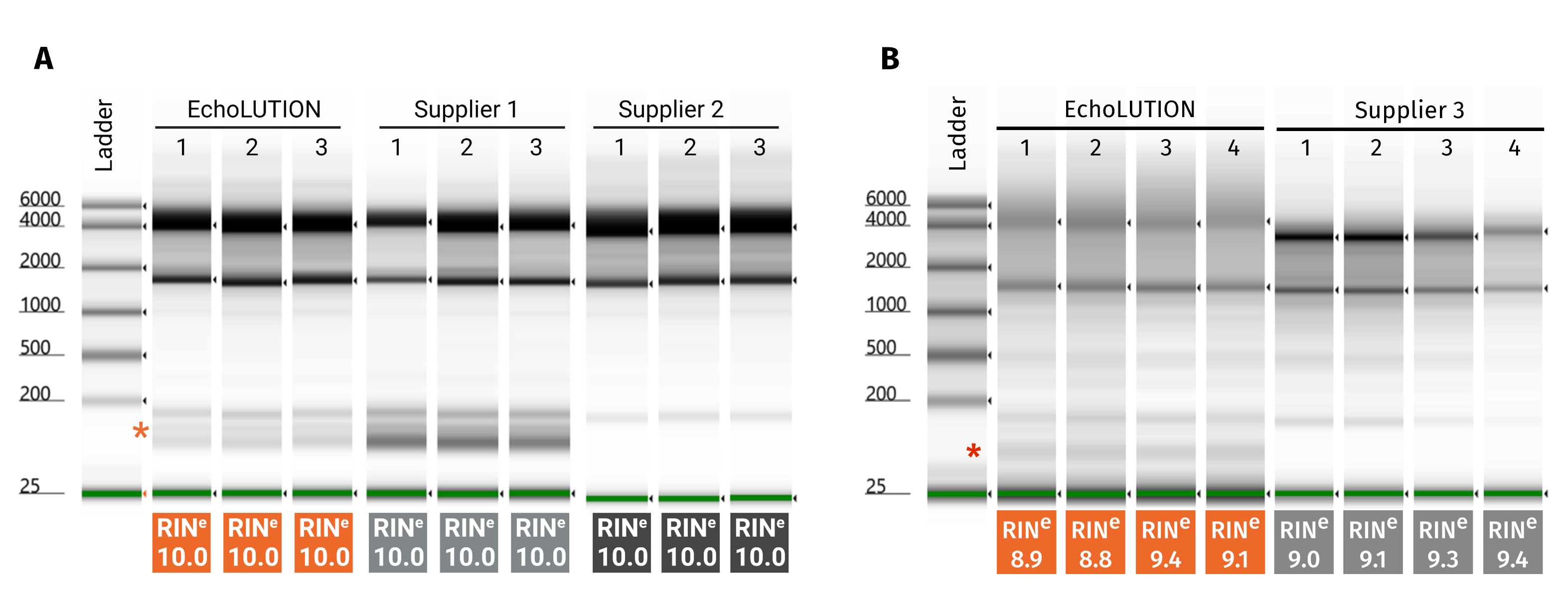
Most of our products are shipped at room temperature. Upon arrival, please check the labels as some components might be stored at 2–8°C. Some of our RNA products have components that are shipped cold, please make sure to store them at –20°C upon arrival.
We ship worldwide! You can find our official distributors here. If your country is not listed, you can order online or send your order to orders@bioecho.eu.
If you have problems with the delivery of your package, please contact orders@bioecho.eu.
All prices are stated excl. VAT plus shipping costs and possible delivery charges, if not stated otherwise. Please note that for correct display of shipping costs, you need to be registered and logged in. Customs fees may apply in your country, please check with your local customs office. To check the overview of shipping and handling costs, please click here.
Please use your e-mail address and password to log in. To reset your password, please click on I have forgotten my password and we will send you a confirmation email with your new password. Click the link in that email to change your password. Note that the link will be valid only for two hours.
BioEcho has a global network of distribution partners. Depending on your location, your order request will be routed to the distribution partner in charge for you to receive a quote.
To view your order history, log in to your account and click on “Orders” in the navigation on the left.
If you are logged in, you can view and edit your account information, including addresses. Click on “Addresses” in the navigation on the left or in the “My account” navigation on top (person icon). You can add addresses and define the default billing and shipment addresses.
Please contact us at contact@bioecho.de and we will support you in placing your order.
We accept upfront payments via PayPal and credit card (Mastercard, Visa) or will be happy to send you an invoice. See Shipping and Payment. If you are logged in, you can change your preferred payment method by clicking on “Payment methods” in the navigation on the left or in the “My account” navigation on top (person icon).

